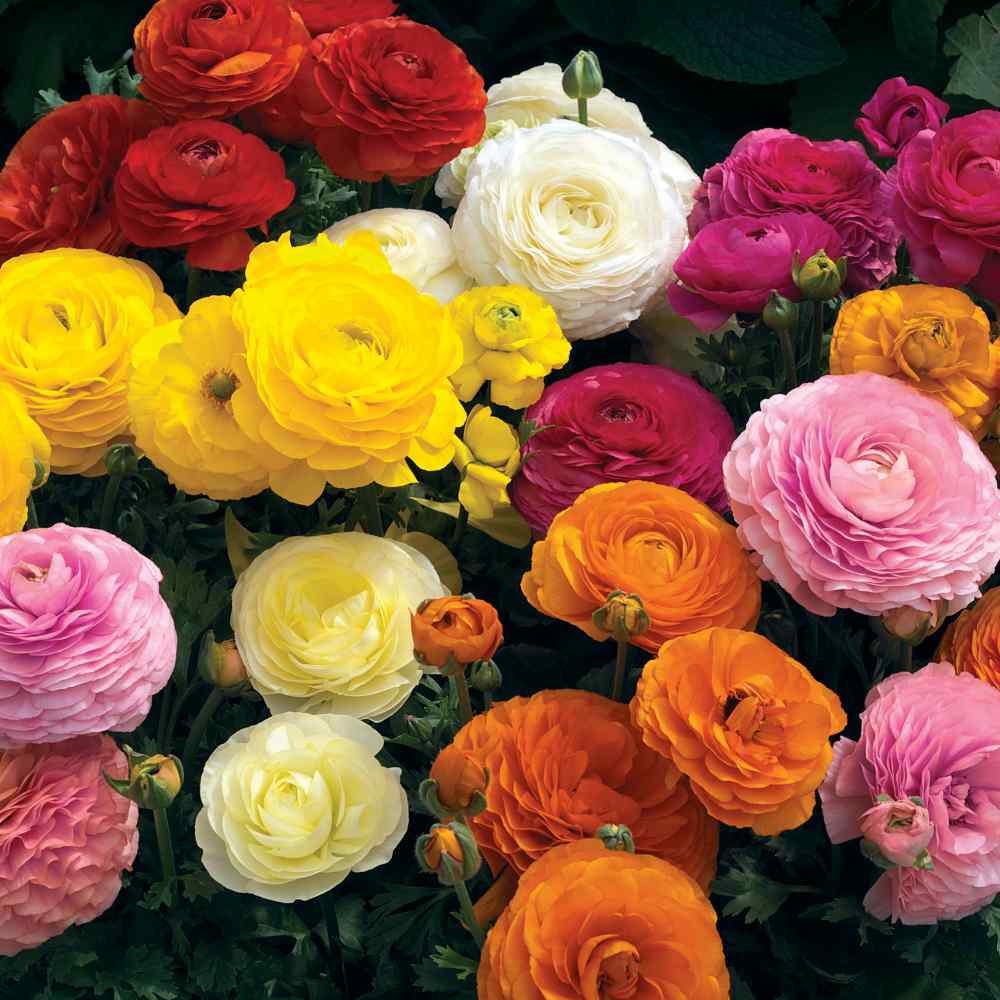Ranunculus is a genus of perennial or annual herbs in the Ranunculaceae family. The leaves are usually alternate and palmately lobed or divided. While the thimble-like, April-blooming, often shiny flowers are most commonly yellow, cultivars have been bred bearing many other colors such as orange, pink, red, and white. The flowers give way to a head of small, dry achenes; because of this, some species can be a bit weedy in disturbed areas. However, they are great pollinator plants and serve as food for hummingbirds. Consider using them for beds, borders, rock gardens, and fresh cut flowers.
These plants do best in full to PM sun. When planting, cover the tuberous roots 3 in. (7.5 cm) in soil and space 3-6 in. (8-15 cm) apart. Soak the tubers for 1 hour before planting or water well once planted. The foliage tends to die down in the summer.
| Ranunculus asiaticus | |
|---|---|
| Scientific classification | |
| Kingdom: | Plantae |
| Clade: | Tracheophytes |
| Clade: | Angiosperms |
| Clade: | Eudicots |
| Order: | Ranunculales |
| Family: | Ranunculaceae |
| Genus: | Ranunculus |
| Species: | |
| Binomial name | |
| Ranunculus asiaticus | |
/ranunculus-56e4a03b5f9b5854a9f90ec2.jpg)
Ranunculus asiaticus, the Persian buttercup, is a species of buttercup (Ranunculus) native to the eastern Mediterranean region in southwestern Asia, southeastern Europe (Crete, Karpathos and Rhodes), and northeastern Africa.[1]
Plant database entry for Persian Buttercup (Ranunculus asiaticus) with 50 images and 20 data details. × New and Unread Tree-Mails. × Share This Page. Use these convenient icons to share this page on various social media platforms. Persian buttercups (Ranunculus asiaticus) are beloved for their brilliantly colored and ruffled petals, tall stems, and long vase life. Their color range—from bright pink, red, and purple to cream, pale yellow, and orange—makes them a favorite at florist shops and in wedding bouquets. Plant database entry for Persian Buttercup (Ranunculus asiaticus) with 50 images and 20 data details. Persian buttercups appreciate a cool spring. In climates where they are hardy, plant in moist, well-drained soil two inches below the soil line. They will emerge in early spring and bloom with large, multi-petaled flowers in mid-spring. For best results, ensure that winter soils are not wet.
It is a herbaceousperennial plant growing to 45 cm tall, with simple or branched stems. The basal leaves are three-lobed, with leaves higher on the stems more deeply divided; like the stems, they are downy or hairy. The flowers are 3–5 cm diameter, variably red to pink, yellow, or white, with one to several flowers on each stem.[2]
It is a protected species in some jurisdictions, including Israel.
Ranunculus Mixed (persian Buttercup)
Cultivation and uses[edit]
Double-flowered forms, which are likely hybrids, are a popular ornamental plant in gardens, and widely used in floristry. Numerous cultivars have been selected, including 'Bloomingdale', 'Picotee', 'Pot Dwarf', and 'Superbissima'. The plants can tolerate light frost, but are not hardy at temperatures below -10 °C.[2]
'Tecolote' and 'Bloomingdale' are examples of the double-flowered plants (not shown here). The single-flowered species form is not commercially cultivated on any significant scale. By contrast, the similar-looking Anemone coronaria is widely available in single-flower 'De Caen' hybrid forms. However, as with Ranunculus asiaticus, the species form, which also has red single flowers, is not commercially cultivated.

References[edit]

- ^'Ranunculus asiaticus'. Germplasm Resources Information Network (GRIN). Agricultural Research Service (ARS), United States Department of Agriculture (USDA). Retrieved 16 January 2018.
- ^ abHuxley, A., ed. (1992). New RHS Dictionary of Gardening. Macmillan ISBN0-333-47494-5.
External links[edit]

Ranunculus Asiaticus
- Media related to Ranunculus asiaticus at Wikimedia Commons
Ranunculus Persian Buttercup
Persian Buttercup Ranunculus Bulbs

